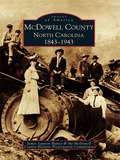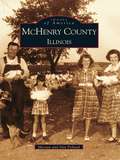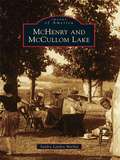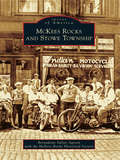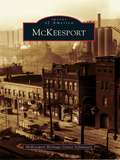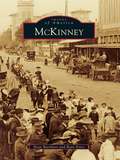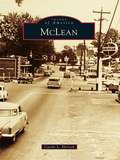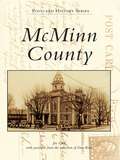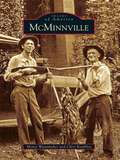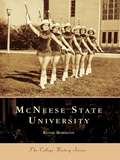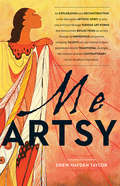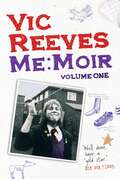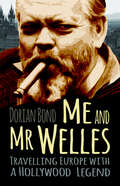- Table View
- List View
McDowell County, North Carolina 1843-1943
by James Lawton Haney McDowell County Historic Preservation CommissionMcDowell County is unique culturally and topographically. Formed by legislative action in 1842 from Burke and Rutherford Counties, McDowell's northern and western borders trace the towering heights and rugged terrain of the Blue Ridge, while its eastern and southern borders incorporate broad river bottoms and lower hills of the Piedmont. Showcasing more than 220 images, this volume is a mosaic of McDowell County's first century and covers the towns of Marion and Old Fort, as well as smaller communities like Brackettown, Crooked Creek, Dyartsville, Glenwood, Greenlee, Little Switzerland, Montford's Cove, Nebo, and North Cove. Views of waterfalls on the Catawba River and Tom's Creek, along with those of the eerie limestone formations of Linville Caverns, attest to nature's bounty. Aging photographs, many of which are published for the first time, draw attention to families, churches, schools, memorable personalities, and historic sites. This collection also brings to life the county's defining events: the arduous construction of two railways through the mountains, the destruction of Marion by fire in 1894, the disastrous flood of 1916, the textile strike of 1929, and the patriotic response by the citizenry to national crises. Photographs of selected homes, commercial sites, churches, and schools testify to the diverse architectural style and levels of economic and social well-being found in the county.
McHenry County, Illinois
by Dan Pelland Maryan PellandMcHenry County, Illinois, is a picture-perfect farming community in the Heartland of Midwestern America. For nearly two centuries, a portion of the nation's food supply has come from this fertile land near the Fox River, and it has played a key role in the history of Chicago and the United States. Through the medium of historic photographs, this book captures the evolution of the people of McHenry County, from the mid-1800s to the second half of the twentieth century.These pages bring to life the people, events, communities, and industries that helped shape and transform McHenry County. With more than 200 vintage images, culled from three collections-the McHenry County Historical Society, the Crystal Lake Historical Society, the James Keefe Collection, and the personal collection of Don Peasley-McHenry County, Illinois, portrays life against a backdrop of international wars, national social struggles, and technological advances in an expanding world.
McHenry and McCullom Lake
by Sandra Landen MachajCome along to McHenry. Nestled between the Fox River and McCullom Lake, it is a friendly, welcoming city with a rich history. It was designated as the first county seat of the newly formed McHenry County in 1837. Its surrounding farmland provided both food from its crops and milk from its cows to the Chicagoarea. Diverse businesses such as boatbuilders, ice cutters, lumber companies, flour mills, brick makers, and cigar makers chose to make McHenry their home. It is a unique city that grew as three separate business districts: along the river, along the railroad, and one in between. Known as the gateway to the Chain of Lakes, tourism thrived in the early 1900s as visitors from Chicago made McHenrytheir recreational destination. In McHenry and McCullom Lake, one will meet the people who helped change McHenry from a collection of log cabins on theriverfront to a bustling city with a population of 24,000.
McKees Rocks and Stowe Township (Images of America)
by McKees Rocks Historical Society Bernadette Sulzer AgreenMcKees Rocks and Stowe Township, just downriver from the Point of Pittsburgh, contributed significantly to the growth of steel and transportation in western Pennsylvania. In 1888, the Pittsburgh and Lake Erie Railroad, known as the "Little Giant," built a 100-acre maintenance facility in McKees Rocks, igniting the spark to the region's massive industrial, business, and population explosion. By 1910, the population soared to 15,000, fueled by the rapid influx of nearly 6,000 immigrants. A landmark event in labor history occurred in July 1909, when 5,000 foreign workers, representing 16 different nationalities, waged a long and bloody strike against the Pressed Steel Car Company. McKees Rocks and Stowe Township showcases a region whose diverse history includes the largest Native American mound in Pennsylvania, visits by George Washington, floods, and even Al Capone. Today a rich mix of ethnic cultures still flavors the local neighborhoods, and the accomplishments of homegrown businessmen, musicians, clergy, athletes, public servants, artists, and educators are recognized and respected throughout western Pennsylvania and beyond.
McKeesport
by McKeesport Heritage Center VolunteersLocated at the confluence of the Youghiogheny and Monongahela Rivers, McKeesport was settled by David McKee in 1755. In 1769, McKee acquired land from the Colonial government and one of his sons, John, laid out a village that became known as McKee's Port because a ferry was operating there. Early industries included coal mining and the building of flatboats, and in 1851, an ironrolling mill was started. Industry continued to boom as steamboats and railroads soon appeared, and in 1872, National Tube was founded and joined by other steel industries and foundries. The growing industries created an abundance of jobs, and immigrants from throughout Europe flocked to the area. McKeesport still maintains a strong ethnic heritage. Through vintage photographs, McKeesport documents the history of this once booming steel town from the development and subsequent loss of its major industry to its recent revitalization.
McKinney
by Ryan Estes Ryan BarnhartMcKinney's very first settlers began arriving from Kentucky, Arkansas, and Tennessee in the early 1840s. Collin County was created by the Texas legislature on April 3, 1846, and due to a provision violation requiring the county seat to be within 3 miles of the center of the county, McKinney replaced Buckner as the seat in 1848. The vote deciding the new seat, however, went in McKinney's favor primarily because flooding kept many citizens from casting ballots. On March 16, 1848, the state legislature passed an act to name the new town in honor of Collin McKinney, one of five original draftees of the Texas Declaration of Independence. Today McKinney is one of America's fastest growing cities and has seen a population boom from approximately 16,000 residents in 1985 to more than 120,000 in 2010.
McLean (Images of America)
by Carole L. HerrickMcLean was a farming community in 1910, when Henry Alonzo Storm established a general store that included the McLean Post Office; the opening of Storm's Store is considered McLean's unofficial beginning. The store was located on Chain Bridge Road beside a stop on the Great Falls and Old Dominion Railroad, an electrified trolley that ran from Rosslyn to Great Falls Park. The stop was named after John R. McLean, a founder of the trolley and owner of the Washington Post newspaper. A village and vibrant community gradually developed around Storm's Store. The Franklin Sherman School, the first consolidated public school in Fairfax County, opened near the store in October 1914; McLean Day, the first event of its kind in the county, started in 1915 to raise money for the school; and the McLean Volunteer Fire Department incorporated in 1923 as Station 1 in Fairfax County.
McLuhan’s Galaxies: Science Fiction Film Aesthetics in Light of Marshall McLuhan’s Thought (Second Language Learning and Teaching)
by Artur SkweresThis groundbreaking book uses observations made by Marshall McLuhan to analyze the aesthetics of science fiction films, treating them as visual metaphors or probes into the new reality dominated by electronic media: - it considers the relations between the senses and sensuality in Blade Runner, the visually-tactile character of the film, and the status of replicants as humanity’s new clothes; - it analyzes the mixture of Eastern and Western aesthetics in Star Wars, analyzing Darth Vader as a combination of the literate and the tribal mindset; - it discusses the failure of visual society presented in the Terminator and Alien franchises, the rekindling of horror vacui, tribalism, and the desire to obliterate the past as a result of the simultaneity of the acoustic space; - finally, the book discusses the Matrix trilogy and Avatar as being deeply related in terms of the growing importance of tactility, easternization, tribalization, as well as connectivity and the implosion of human civilization.
McMinn County
by With Postcards Reid Joe GuyMcMinn County was founded in 1819 on land previously owned by the Cherokee Nation. Situated in Southeast Tennessee, McMinn County is halfway between Knoxville and Chattanooga, Atlanta and Bristol, and New York and Miami. For its citizens, it remains a rural county of mountain ridges with deep hollows and wide, creek-watered valleys; its different topography also defines the diverse people who, for 150 years, have called McMinn County home. Postcard History Series: McMinn County features many long-forgotten scenes from Athens, Englewood, and Etowah. All three have different histories, different people, and different stories to tell.
McMinnville
by Monty Wanamaker Chris KeathleyLying at the western base of the Cumberland Table Land, the Middle Tennessee country in which McMinnville was situated in 1810 was generally referred to as the "Mountain District" and the town as the "Mountain City." Since its height is several hundred feet above Nashville and the counties of the basin, the town has enjoyed the distinction of the cool mountain air along with the fertility of its surrounding valleys. McMinnville, the county seat of Warren County, is presented here by its authors in an assemblage of images commemorating its 200-year history. The images are selected primarily from the authors' archives, augmented by selections from the Tennessee State Library and Archives in Nashville.
McNeese State University
by Kathie BordelonSurrounded by live oaks and azaleas, McNeese State University has served Southwest Louisiana for over sixty years. Founded in 1939 by area businessmen and cattlemen, the university has grown and thrived side by side with the city of Lake Charles. Alumni, faculty, staff, and students alike take pride in the heritage of their evolving university, and the city embraces the school as a treasured landmark of the community. McNeese State University began as Lake Charles Junior College, a division of Louisiana State University. Just one year after its inception, the name was changed to John McNeese Junior College in honor of one of the area's foremost pioneer educators. In 1950 the name was changed to McNeese State College when four-year status was obtained, and university status was achieved in 1970. The campus has enjoyed phenomenal expansion, from its initial three buildings constructed on the site of the town's Poor Farm to the vibrant and sprawling 68 buildings and over 500 acres it consists of today. Scenes of student life--in classrooms, dormitories, club meetings, and at athletic events--as well as memorable events throughout the course of the school's history are the focus of this visual journey. Students are pictured during lighter moments, enjoying the camaraderie of their classmates, but their serious side is also displayed during such trials as the disastrous hurricane that forced over 1,000 refugees to shelter on campus and the period during World War II when the campus became the headquarters of the Louisiana Maneuvers. Notable alumni of McNeese State include Dr. Cecil Cyrus Vaughn, a pioneer in cardiovascular medicine and artificial transplant surgery; Sheryl L. Abshire, one of the first five inductees into the National Teacher Hall of Fame and a Christa McAuliffe Fellow; and Andre Dubus, a critically acclaimed writer.
Me & My 18" Doll: Sew 20+ Matching Outfits, Accessories & Quilts for the Girl in Your Life
by Erin HentzelA match made in heaven! Sewing patterns for little girls and their eighteen-inch dolls Dressing like your doll has never been so much fun! Make stylish coordinates, modern accessories, and cozy quilts for little girls and the dolls they love. Each project comes in a standard 18” doll size and a child’s size (with the clothing in sizes 6–12), so you can customize the perfect pairing! Get the best possible fit for garments by learning to self-draft some of the patterns—a helpful skill to learn as your children grow. Twinning! Sew over twenty coordinating projects for kids and eighteen-inch dolls, from cute clothing and accessories to adorable quilts Inspire creative play with graded clothes patterns (sizes 6–12) and doll duplicates Best-selling author Erin Hentzel shares her signature attention to detail and adorable style
Me & My Sewing Adventure: An Intermediate Guide
by Kate HaxellFollow-up to the best seller Me & My Sewing Machine! • Advance your skills in garment, home dec, and accessory sewing with this practical teaching guide • Simple (foolproof!) instructions and helpful photographs make it easy to learn challenging techniques • Bonus! 6 projects put the lessons to work After learning the basics in Me & My Sewing Machine, it’s now time to graduate to more sophisticated techniques in this follow-up book, Me & My Sewing Adventure. With her characteristic clarity and easy-to-follow instructions, author Kate Haxell guides you through the challenges and nuances of professional finishes, fabric manipulation, specialty seams, pattern construction, and much more. Once you master these skills, you’ll approach any sewing endeavor with a newfound confidence and ease. The book also includes an inspiring historical overview of vintage machines to complete your sewing education.
Me Artsy
by Drew Hayden TaylorThere are a few questions that professional artists get asked regularly: Where do you get your ideas? How did you get started? And be honest--are you really in it for the money?Following the highly successful Me Funny and Me Sexy anthologies, Me Artsy answers these eternal questions and more. With essays from fourteen First Nations artists from a variety of disciplines, the collection provides insight into the paths that led each artist to pursue and develop his or her craft. The essays explore many common themes around the role of art in First Nations communities, including the importance of art for creating social change, the role of art in representing Native culture and the fusion of traditional and contemporary techniques. On a more personal level, the essays describe the significance of art in the lives of the contributors, along with their sometimes unlikely journeys to success, stories which are often touched with humour and humility.Chef David Wolfman describes gruelling years of prep work in the kitchens of the exclusive National Club; filmmaker Zacharias Kunuk discusses leaping into his first feature film without knowing how to finance it; fashion designer Kim Picard describes making a dress inspired by coffee beans; and playwright Drew Hayden Taylor tells the story of putting a bullet through his first play and burying it in his yard. Other contributors include actor/playwright Monique Mojica, painter Marianne Nicolson, painter Maxine Noel, blues pianist Murray Porter, scholar Karyn Recollet, dancer/choreographer Santee Smith, director/actor Rose Stella, drummer Steve Teekens, writer Richard Van Camp and manga artist Michael Nicholl Yahgulanaas.
Me Make Monster: A Mish-Mash of Monstercraft
by Jenny Harada'They hide in your closet. They lurk under the bed. They tickle your feet and devour your pillows. They're monsters only a mother could love. In Me Make Monster, Jenny Harada presents a hoard of funky monster projects so ugly they're cute. Bring to life your own fantastic brood as you follow step-by-step instructions to create a true mish mash of monsterdom--everything from plush huggable beasties and a furry pillow cover to a fanged fiendish trinket box and google-eyed dice. Whatever kind of monster may tickle your fancy (or your feet) you'll find one of his breed to spawn and love.Discover within the pages:Step-by-step instructions to make 18 fantastic creaturesMonsters made from all different types of material--from fun fur to plywood to junk mailVariation beasties for even more impish inspirationA history of monsters and information on each monster's fanciful personality So get out your glue, dust off the sewing machine, hide your valuables and channel your inner Frankenstein!
Me Moir - Volume One
by Vic ReevesVic Reeves' vivid, enchanting, and utterly hilarious childhood memoir is a comic masterpiece.Before there was Vic Reeves, there was a boy called James Moir who was much the same as any other lad.Obsessed with owning a pet crow, a master at writing his name and terrified of his father's immense moustache. Growing up in Yorkshire and then CountyDurham, the boy who would be Reeves somehow managed to escape the attentions of 'Randy Mandy' and get a crash course in pig castration, before having encounters with Jimi Hendrix and the Yorkshire Ripper.Peopled with weird and wonderful characters, Vic Reeves' memoir is authentic, witty and inventive, and as unique as you'd expect from one of Britain's most exceptional comedy talents.
Me Talk Pretty One Day
by David SedarisA hilarious collection of essays from 'the premier observer of our world and its weirdnesses,' New York Times bestselling author David Sedaris (Adam Kay, author of This is Going to Hurt)Anyone who has heard David Sedaris speaking live or on the radio will tell you that a collection from him is cause for jubilation. A move to Paris from New York inspired these hilarious pieces, including 'Me Talk Pretty One Day', about his attempts to learn French from a sadistic teacher who declares that 'every day spent with you is like having a caesarean section'. His family is another inspiration. 'You Can't Kill the Rooster' is a portrait of his brother, who talks incessant hip-hop slang to his bewildered father. And no one hones a finer fury in response to such modern annoyances as restaurant meals presented in ludicrous towers of food and cashiers with six-inch fingernails.Readers say:'Fantastically funny book which gets better and better''Oh how I loved this book. David Sedaris and his adventures in learning to speak French made me cry with laughter, especially the terrifying teacher at the language classes''Why have I not discovered him before'
Me Talk Pretty One Day
by David SedarisAnyone that has read NAKED and BARREL FEVER, or heard David Sedaris speaking live or on the radio will tell you that a new collection from him is cause for jubilation. His recent move to Paris from New York inspired these hilarious new pieces, including 'Me Talk Pretty One Day', about his attempts to learn French from a sadistic teacher who declares that 'every day spent with you is like having a caesarean section'. His family is another inspiration. 'You Can't Kill the Rooster' is a portrait of his brother, who talks incessant hip-hop slang to his bewildered father. And no one hones a finer fury in response to such modern annoyances as restaurant meals presented in ludicrous towers of food and cashiers with six-inch fingernails.
Me and Banksy
by Tanya Lloyd KyiA Banksy-style protest against cameras in classrooms brings a group of middle-grade students together. For fans of Rebecca Stead, Susin Nielsen and Gordon Korman. <P><P>Dominica's private school is covered in cameras, and someone is hacking into them and posting embarrassing moments for the whole school to see. Like Ana picking her nose. When Dominica quickly changes her shirt from inside out in what she thinks is the privacy of a quiet corner in the library, she's shocked -- and embarrassed -- to discover a video has captured this and is currently circulating amongst her schoolmates. So mortifying, especially since over the past three years, they've had a half-dozen school talks about social media safety. <P><P>Who has access to the school security cameras and why are they doing this? Dominica and her best friends, Holden and Saanvi, are determined to find out, and in the process start an art-based student campaign against cameras in the classroom.
Me and Mr Welles: Travelling Europe with a Hollywood Legend
by Dorian Bond‘I’ll tell you another thing, Dorian. Don’t ever give people what you think they want. Give them what they never conceived as possible.’ In late autumn 1968, Dorian Bond was tasked with travelling to Yugoslavia to deliver cigars and film stock to the legendary Hollywood director Orson Welles. The pair soon struck up an unlikely friendship, and Welles offered Bond the role of his personal assistant – as well as a part in his next movie. No formal education could prepare him for the journey that would ensue. This fascinating memoir follows Welles and Bond across Europe during the late 1960s as they visit beautiful cities, stay at luxury hotels, and reminisce about Winston Churchill and Franklin Roosevelt, among others. It is filled with Welles’ characteristic acerbic wit – featuring tales about famous movie stars such as Laurence Olivier, Marlene Dietrich and Steve McQueen – and is a fresh insight into both the man and his film-making. Set against the backdrop of the student riots of ’68, the Vietnam War, the Manson killings, the rise of Roman Polanski, the Iron Curtain, and Richard Nixon’s presidency, Me and Mr Welles is a unique look at both a turbulent time and one of cinema’s most charismatic characters.
Me and My Bike: Portraits of a Cycling Nation
by Donato Cinicolo EsqAround the world it is estimated that 130 million bicycles are sold every year, making the trusty bike our favourite mode of transport whether we are commuting to work or cycling for pleasure. Bikes come in all shapes and sizes, from the most basic, least expensive models to the most sophisticated sports cycles that can cost as much as a family car. But whether it was bought cheaply or cost a packet, people form a bond with their bikes that becomes a true affair of the heart. Donato Cinicolo has sought out and photographed scores of bicycle lovers including the naturist stuntman who rides a ladies' racer dressed in nothing but fluorescent yellow shorts; the retired postman who rides a retired GPO delivery bike; the old lady who carries her enormous cat in the basket on her handlebars; and the penny farthing fan. From racing geeks to affectionate collectors, every one of Donato's pictures tells a story and, of course, every devoted bike rider has a story to tell.
Me and My Sewing Machine: A Beginner's Guide
by Kate HaxellThis jargon-free, fully illustrated guide to using your sewing machine explains essential techniques and offers easy projects for getting started. Straightforward and accessible, Me and My Sewing Machine contains everything you need to know to get the most out of your sewing machine. There are no intimidating specialty techniques, painstaking procedures, or complicated methods. Instead you will find easy-to-understand, practical and decorative techniques that make sewing simple, even if you have never used a machine before. Author and professional crafter Kate Haxell shares clever tips and shortcuts, as well as advice on when you can use these speedy methods and when it really is better to do something the traditional way. Everything is illustrated with step-by-step photography and finished samples. Haxell also includes easy sewing projects that are simple without skimping on style.
Me, Frida, and the Secret of the Peacock Ring (Scholastic Press Novels)
by Angela Cervantes<P><P>A room locked for fifty years. <P><P>A valuable peacock ring. <P><P>A mysterious brother-sister duo. <P><P>Paloma Marquez is traveling to Mexico City, birthplace of her deceased father, for the very first time. She's hoping that spending time in Mexico will help her unlock memories of the too-brief time they spent together. <P><P>While in Mexico, Paloma meets Lizzie and Gael, who present her with an irresistible challenge: The siblings want her to help them find a valuable ring that once belonged to beloved Mexican artist Frida Kahlo. <P><P>Finding the ring means a big reward -- and the thanks of all Mexico. What better way to honor her father than returning a priceless piece of jewelry that once belonged to his favorite artist! <P><P>But the brother and sister have a secret. Do they really want to return the ring, or are they after something else entirely?
Mean Girl Feminism: How White Feminists Gaslight, Gatekeep, and Girlboss (Feminist Media Studies)
by Kim Hong NguyenWhite feminists performing to maintain privilege Mean girl feminism encourages girls and women to be sassy, sarcastic, and ironic as feminist performance. Yet it coopts its affect, form, and content from racial oppression and protest while aiming meanness toward people in marginalized groups. Kim Hong Nguyen’s feminist media study examines four types of white mean girl feminism prominent in North American popular culture: the bitch, the mean girl, the power couple, and the global mother. White feminists mime the anger, disempowerment, and resistance felt by people of color and other marginalized groups. Their performance allows them to pursue and claim a special place within established power structures, present as intellectually superior, substitute nonpolitical playacting for a politics of solidarity and community, and position themselves as better, more enlightened masters than patriarchy. But, as Nguyen shows, the racialized meanness found across pop culture opens possibilities for building an intersectional feminist politics that rejects performative civility in favor of turning anger into liberation.
Mean Little Deaf Queer: A Memoir
by Terry GallowayIn 1959, the year Terry Galloway turned nine, the voices of everyone she loved began to disappear. No one yet knew that an experimental antibiotic given to her mother had wreaked havoc on her fetal nervous system, eventually causing her to go deaf. As a self-proclaimed "child freak," she acted out her fury with her boxy hearing aids and Coke-bottle glasses by faking her own drowning at a camp for crippled children. Ever since that first real-life performance, Galloway has used theater, whether onstage or off, to defy and transcend her reality. With disarming candor, she writes about her mental breakdowns, her queer identity, and living in a silent, quirky world populated by unforgettable characters. What could have been a bitter litany of complaint is instead an unexpectedly hilarious and affecting take on life.
